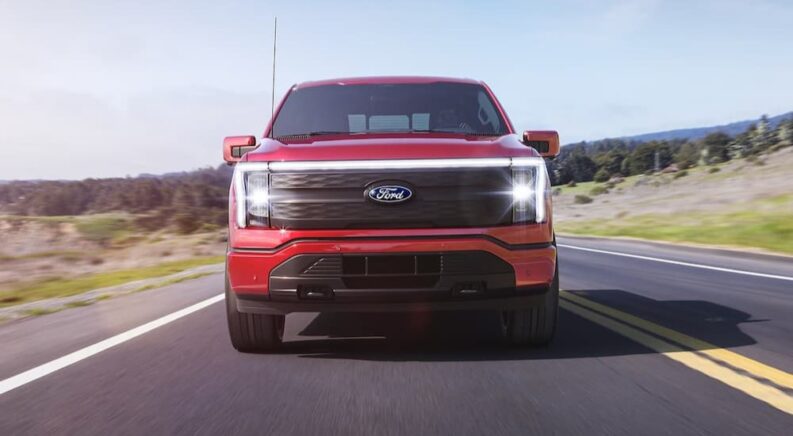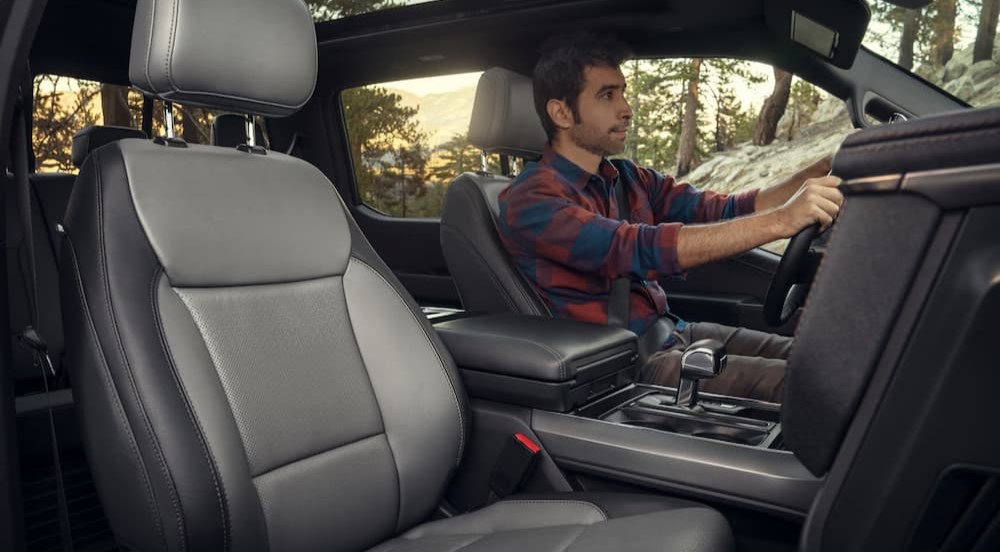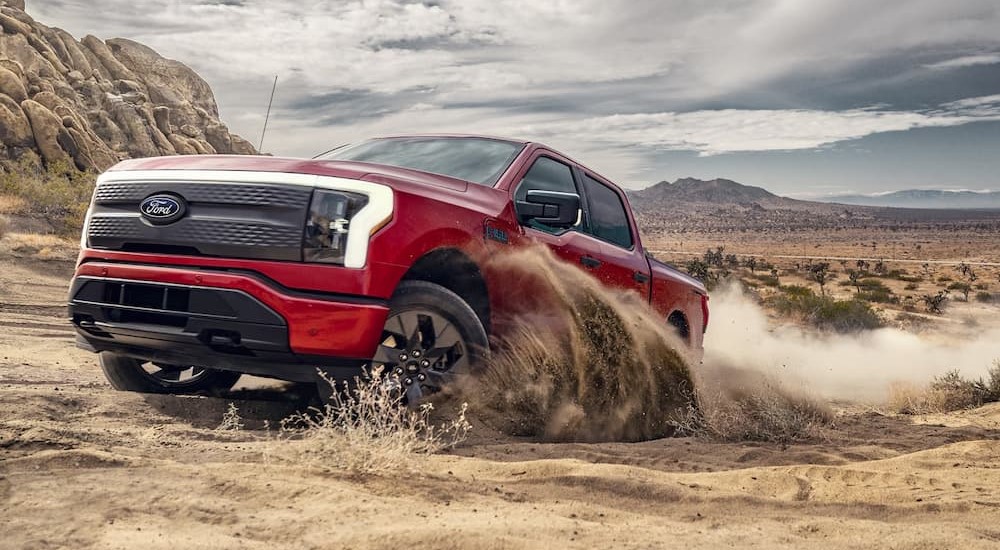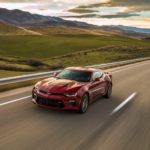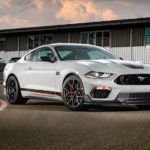Those in the market for a thrilling ride have no shortage of stylish, curve-hugging sports cars to choose from. Names like Porsche, Mercedes, BMW, and Mazda tend to dominate this high-speed market sector, but those seeking a decidedly different way to burn a little rubber have an inciting new option, courtesy of Ford. While the Blue Oval’s original pony car might spring to mind, we’re actually talking about a more recent model…
Weighing in at nearly 7,000 lbs and measuring almost twenty feet long, the Ford F-150 Lightning is about as unlikely of a speedster as you can imagine—but the numbers don’t lie. This pickup’s all-electric design allows it to rocket from zero to sixty in just 4.0 seconds and hit the quarter-mile in 12.7—numbers that wouldn’t be out of place at your local race track. Those on the hunt for a Ford F-150 Lightning for sale will discover that this truck isn’t just faster than the sports cars on our list, but it also manages to outpace one of Ford’s most unhinged pickup creations in the borderline super-truck that is the F-150 Raptor.
So, how did the F-150 Lightning get so fast, and which sports car could it best in a zero-to-sixty sprint or quarter-mile race? We’ve compiled a list of some current models that would be left choking on this pickup’s dust to illustrate just how powerful Ford’s new all-electric creation is.
The EV Advantage
Before we dive into our list, let’s take a moment to ask ourselves one important question: How? Weighing between 6,000 and 6,800 lbs, the Ford F-150 Lightning is even a hefty model when compared to many of its competitors in the full-size pickup segment. The fact that this truck can hit 60 mph in just four seconds might defy logic, but it all comes down to torque.
For those whose eyes glaze over at the mention of the word “physics”, we’ll give you a quick and dirty definition of this rather complex concept: In the most basic terms, torque is simply the amount of rotational force an engine (or, in the case of an EV, an electric motor) can produce; this rotational force travels from the motor to the transmission, out to the driveshaft, and eventually to the tires themselves. When it comes to a vehicle’s ability to accelerate, it’s torque—not horsepower—that’s really the deciding factor (though the Lightning certainly excels in both categories, with 580 ponies on tap).
EVs like the F-150 Lightning offer some of the best torque in today’s market thanks to their electric motors. While a traditional gas-powered engine has to slowly work its way to peak efficiency as it climbs through each of the transmission’s gears, an EV like the Lightning can instantaneously deliver every ounce of its 755 lb-ft of torque the moment you step on the accelerator, thanks to the fact that they’re built with a single-speed transmission.
This approach provides an efficient alternative to gas-powered vehicles when it comes to accelerating from a dead stop, though it can be a bit limiting when it comes to higher-speed applications where acceleration tends to plateau. The same instant torque that can help you launch off the starting line can also come in handy in low-speed scenarios, such as when you’re navigating rough, uneven off-road terrain where torque and traction are often so vital to ensuring success.
The F-150 Lightning has one more trick up its sleeve when it comes to acceleration—or rather, two. Every F-150 Lightning comes standard with dual electric motors located in the front and middle of the vehicle. These two motors send power to every corner of the Lightning, virtually eliminating wheelspin and enabling the sort of off-the-line traction that’s so important for getting a quick start. Its all-wheel drivetrain also confers some much-appreciated benefits for off-roading, as every wheel does its part to chew through mud, sand, snow, and other loose surfaces.
The Leader of the Pack
Ford F-150 Lightning
Zero to Sixty: 4.0 seconds
Quarter-Mile: 12.7 seconds @ 107 mph
Before we see how it stacks up with some of the speediest models in the sports car category, let’s take a closer look at the F-150 Lightning itself. Ford’s first EV pickup is available with dual electric motors paired with either a Standard Range battery that’s good for 452 hp or an Extended Range version that puts out a whopping 580 hp. Both batteries churn out 775 lb-ft of torque, which, as we discussed, is the real deciding factor when it comes to acceleration.
It’s the liquid-cooled, lithium-ion, 131-kWh Extended Range battery that allows the Lightning to achieve its eye-popping zero-to-sixty time of 4.0 seconds, but the Standard Range isn’t all that far behind at 4.2 seconds. The Lightning posts a quarter-mile time of 12.7 seconds at 107 mph and has an officially listed top speed of 110 mph. (Read the fine print and you’ll discover that this 110-mph mark is actually limited by a governor, so only Ford knows what sort of speeds the EV pickup is actually capable of.)
All Those Playing Catch-Up
BMW 230i
Zero to Sixty: 5.1 seconds
Quarter-Mile: 13.7 seconds @ 101 mph
The F-150 Lightning’s first victim is BMW’s compact luxury coupe, the 230i. While some of this sports car’s upper trims—like the all-wheel-drive 240i xDrive—can best this pickup by the narrowest of margins, the entry-level version is a relative slowpoke with a zero-to-sixty time of 5.1 seconds. The 230i’s 155-mph top speed means the coupe would eventually be able to overtake the Lightning in a sufficiently long race, but that gas-powered model’s acceleration is no match for this EV pickup.
Ford Mustang Dark Horse
Zero to Sixty: 4.1 seconds
Quarter-Mile: 12.5 seconds @ 114 mph
Sure, we’re sort of ignoring our own rules when it comes to this inclusion, but allow us to explain… The Lightning just narrowly outpaces its lineup mate when it comes to reaching 60 mph, and it is fractionally slower at a quarter-mile pace by 0.2 seconds, but we just couldn’t resist the chance to compare what many drivers think of as the sportiest Ford model against this electrically-powered newcomer.
In fact, the Lightning does beat the entry-level EcoBoost trim and its turbocharged 315-hp, 2.3-liter four-cylinder engine, but it’s this truck’s ability to keep pace with the range-topping Dark Horse trim that really illustrates the power of the all-electric approach. Powered by a 5.0-liter V8, the Mustang Dark Horse is certainly no slouch, but it’s still funny to picture it going neck and neck with a hulking F-150.
Hyundai Veloster N
Zero to Sixty: 4.8 seconds
Quarter-Mile: 13.4 seconds @ 105 mph
Hyundai’s Veloster is one of the more unique entries on the list; while it’s technically a sports car, it’s also a hatchback, not to mention being one of the few three-door models still on the market. The hot hatch trend is alive and well in the Veloster’s decidedly sporty N trim, but even that’s not enough to keep up with the F-150 Lightning.
The Veloster N is almost a full second slower to 60 mph, with a 4.8-second stat line to its name, though it does a little better in the long run with a quarter-mile of 13.4 seconds. This performance comes courtesy of the Veloster N’s 2.0-liter turbocharged four-cylinder engine, which is capable of 275 hp and 260 lb-ft of torque, though the automatic transmission’s overboost function allows drivers to increase that figure to 278 lb-ft (which still won’t allow it to catch the Lightning).
Lexus RC350 F Sport
Zero to Sixty: 5.6 seconds
Quarter-Mile: 13.1 seconds @ 100 mph
Lexus might be known as Toyota’s luxury sub-brand, but it’s not totally unfamiliar with the concept of performance. However, the RC is a little more refined (and slower) than your run-of-the-mill sports car, with numbers that are unlikely to have Lightning drivers shaking in their boots. A naturally aspirated 3.5-liter V6 gives the RC some 311 hp, but that sports car’s 280 lb-ft of torque is certainly evident when you get a look at its zero-to-sixty time, which, at 5.6 seconds, makes it one of the slower entries on our list.
Those unwilling to part with the extra $2,930 upcharge for the RC350 F Sport will be limited to either a turbocharged four-cylinder engine or a non-turbo V6, which max out at 258 and 236 lb-ft of torque, respectively; this makes the RC a tough sell for those seeking a performance-minded option, though the Lexus’ luxury credentials are pretty solid.
Mazda MX-5 Club
Zero to Sixty: 5.7 seconds
Quarter-Mile: 14.5 seconds @ 95 mph
The Mazda MX-5 (or the Miata, to its friends) has long been one of the most fun convertible sports cars on the road. The best-selling roadster has been a mainstay in the segment for over 30 years and has managed to keep up with the times in its performance. That said, few Miata enthusiasts probably ever pictured a day when the spunky little sportster would get out-sprinted by a truck.
The Miata might only weigh a fraction of what the Lightning does, at 2,345 lbs, but it also only produces 181 hp and 151 lb-ft of torque. From a power-to-weight ratio standpoint, that’s not too shabby, but with a zero-to-sixty time of 5.7 seconds for the softtop and 5.8 for the hardtop, the difference in acceleration is noticeable. The Lightning can’t match the low-slung Miata’s legendary handling, but it will leave the Mazda firmly in its rearview through the quarter-mile.
Mercedes-AMG SL43
Zero to Sixty: 4.5 seconds
Quarter-Mile: 13.5 seconds @ 107 mph
The fact that the Lightning can outpace a Mercedes isn’t all that surprising, but a performance-focused AMG model? That’s a different story entirely. This automaker’s performance branch has turned out some of the most thrilling sports cars in today’s market, but the SL-Class’s entry-level SL43 is no match for this swift pickup.
Powered by a turbocharged 2.0-liter inline-four with 375 hp and 354 lb-ft of torque, the SL43 takes almost a half-second longer to get up to 60 mph. The same doesn’t hold true for the upper trims—which, at 469-577 hp, give the Lightning a literal run for its money—but those versions also edge into the rarified $150,000 territory. If you want to make a Mercedes-AMG driver question their purchase, just keep an eye out for the SL43 next time you’re stopped at a red light.
Toyota GR Supra 2.0
Zero to Sixty: 4.7 seconds
Quarter-Mile: 13.4 seconds @ 104 mph
The Toyota GR comes in two distinct flavors: the Supra 2.0 and 3.0. While the 2.0 might feature the classic Supra styling that’s made the Toyota such a recognizable model, it lacks the true performance bona fides of the souped-up 3.0 version. The 3.0 can claim a 382-hp, turbocharged 3.0-liter inline-six under the hood, but the 2.0 makes do with a 2.0-liter four-cylinder version that is a little underwhelming at 255 hp.
The difference in torque isn’t quite as wide (as the 2.0 comes with 295 lb-ft to the 3.0’s 368 lb-ft), but it has still limited the base trim to a zero-to-sixty time of 4.7 seconds. The 3.0 barely edges out the Lightning at 3.9 seconds, and it’s the Supra to choose if you’re in the market for a little high-speed excitement.
Subaru BRZ Limited
Zero to Sixty: 5.4 seconds
Quarter-Mile: 13.9 seconds @ 101 mph
The Subaru BRZ is notable for being the only Subaru not offered with all-wheel drive, though drivers will likely forgive the coupe since it’s also the brand’s sportiest model, with a zero-to-sixty time of 5.4 seconds and a top speed of 140 mph. This sort of acceleration is made possible by the BRZ’s 2.4-liter flat-four, which gives this car 228 hp and 184 lb-ft of torque. Those numbers might sound a little paltry, but when you consider the fact the BRZ only weighs 2,843 lbs, it’s really not that bad.
This Subaru (like its nearly identical cousin, the Toyota GR86) is excessively fun to drive, so it’s hard to get too bent out of shape about its less-than-stellar acceleration numbers. The newest second-generation model, which debuted in 2021, is actually a noticeable improvement over the first-gen version, which posted a 6.0-plus-second zero-to-sixty time, but it still falls well short of the F-150 Lightning.
The F-150 Lightning Lights the Asphalt Ablaze
Looks can be deceiving. From a distance, the Lightning doesn’t appear all that different from a run-of-the-mill F-150; pull up next to the Lightning at a stop light and you’ll notice it has the same bed, ground clearance, and towering height as the rest of the brand’s best-selling pickups, but the gulf in performance will become evident as soon as that light switches from red to green and you’re left watching it disappear into the distance.
This emphasis on speed doesn’t come at the cost of traditional pickup values; the Lightning bests many of its fellow F-150s, with a maximum towing capacity of 10,000 lbs, further proving that this truck’s all-electric design is no hindrance in terms of power. The advent of performance-minded EV technology marks an exciting time in the auto world, and the F-150 Lightning proves just how much of an impact this new breed of all-electric vehicles could have on even the most unlikely segment.

